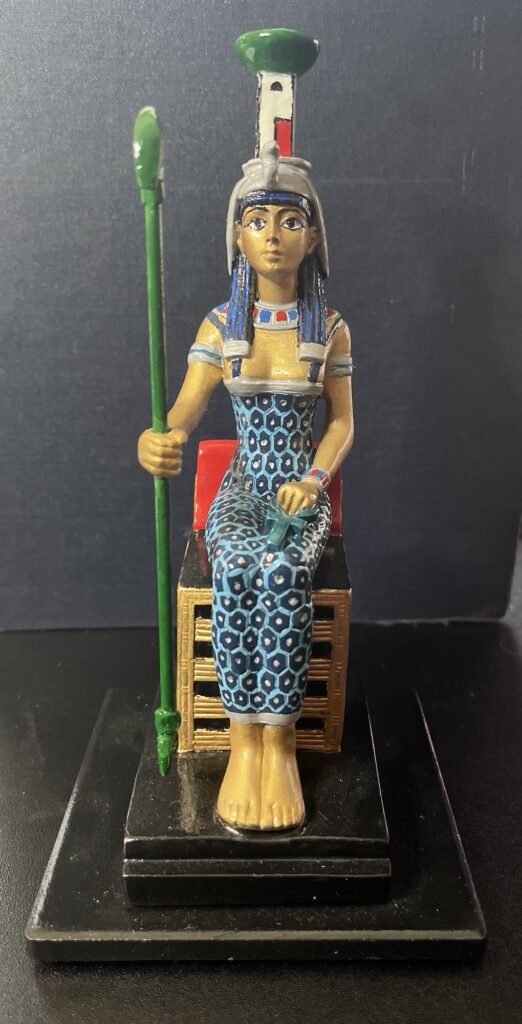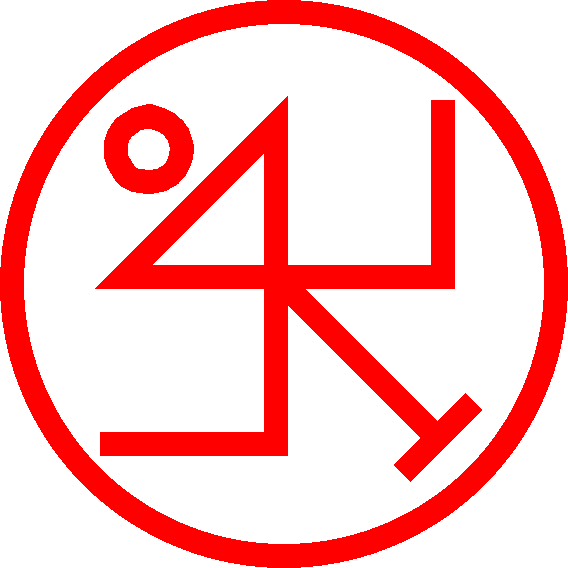The Nephthys figure is the first one I began, since she is the deity I am most devoted to. She was made from a figure sold as Isis, same one that my Isis figure was sold as, but I had to remove the horned disk and give her her hieroglyphic name instead.
Note: The general procedure for the makeover is described on the page for Osiris; additional details on how to make the hieroglyph crown and attach it to the head are provided on the page for Isis.

This is what the Isis figure looked like when purchased. Nephthys looked pretty much identical, as I simply bought two of the same figure.

After initial acetone bath. Note that not all the gold paint is gone yet and there’s a lot more of the black than you will see in the next picture. Again, since Nephthys was my first figure, I was figuring things out as I went.

More acetone and scrubbing eventually got her to this point. What a difference!
Note that in this picture, her wꜣs scepter has been removed (by the acetone ungluing it), and her sun disk as well (via rotary tool; read more in the Isis makeover page, and always use appropriate safety precautions when using power tools.)

Now the glyph is attached to her head. Once again, see the Isis page for information on what material the glyph was made from and how it was securely attached to the head.
The wꜣs scepter is also reassembled and glued into position. Ready for priming.
A note about her glyph: If you look at the gilded statue of her from Tutankhamun’s canopic shrine, her glyph there is rendered flat. I don’t care for that (note that the statue of Serqet has a perfectly 3D scorpion on her head).
The semicircle in Nephthys’s glyph is nb, which represents a basket, and baskets have three dimensions. The ḥwt rectangle is more debatable since it could just be a floor plan of an estate, but the word often means “a mansion” or “a temple”, so I made it a proper building: a rectangular prism, nicely supporting the 3-D basket.

The reason for these holes was to create a stronger joint to hold the throne to the head. This is essentially the same procedure as when you glue a short dowel between two pieces of wood to join them.
What you cannot see in this picture is that there is a short piece of wire, about an inch long, connecting the throne and the head. I put a few drops of Gorilla Glue into each of the holes, and a little more for good measure on the bottom of the throne (a little more; you don’t want overflow), and put the throne onto the head, putting the short piece of wire into the holes on each as I put them together.
When I had given that glue plenty of time to cure, I could actually lift the entire figure by grabbing and lifting the throne.
Then I glued the wꜣs scepter into position in her hand, and glued the two ends of it back on. For this, I used superglue. She was now ready for priming.

After one coat of primer. Note that once again, I did not glue the ceramic tile “extra wide base” onto the bottom of the figure before priming. I now do so when I make these figures. That extra stability is nice if you want to pick up and move the box that the figure is sitting in while the primer dries.

First stages of painting.
Note that I made her throne black and red. I did so because those are my personal favorite colors, and she is my most cherished deity, so in a sense, I am supporting her.
When I later made Isis, I painted her throne largely blue for contrast. Plus, the blue throne under Isis goes well with the blue throne on her head, while the red on Nephthys’s seat goes well with the red rectangle on her glyph.

The ankh is now painted, as is her hair, which is starting to make her come to life.
Another contrast to Isis is in place at this point, but it’s subtle in the picture: her vulture crown is painted not copper in imitation of the rose-gold jewelry of the gods, but silver. Why did I do that? One of the dualities of the two goddesses is night (Nephthys) versus day (Isis). Therefore, I let Isis have the “gold” vulture crown, and made Nephthys’s vulture silver to match the moon. (Also, I prefer silver jewelry to gold myself.)
This was an innovation of mine, but I still like it. When I make Neith and Serqet figures, they will get copper like most of the gods do; that will just ensure that Nephthys is special. 🙂

Her eyes are painted; now she really feels alive. I’ve also put the base layer of color on her dress.
This picture is dark because I actually put her in my altar space for this one, to see how she “felt” there, before I continued. (You may note that she’s sitting on clear wood instead of the black of my crafting table.)
Her armbands and wig ends have been painted now, and like her vulture crown, I made them silver, for the reasons I explained above.
Note that the front of the throne has little red and blue spots on it to suggest colored inlay. Keep that in mind when we get to the last picture.

I’ve painted the pattern onto her dress, added silver to its hems, and I painted over the red and blue “inlay” on the throne. It just didn’t look right to me with everything else going on. If I remade the statuette today, I’d probably have kept it (and it would have been neater, because of the experience I’ve gained since this figure).
She has also received her ceramic tile (note the broader base), clearcoat, and the piece of felt under the base (not visible).
And with that, she was completed!
